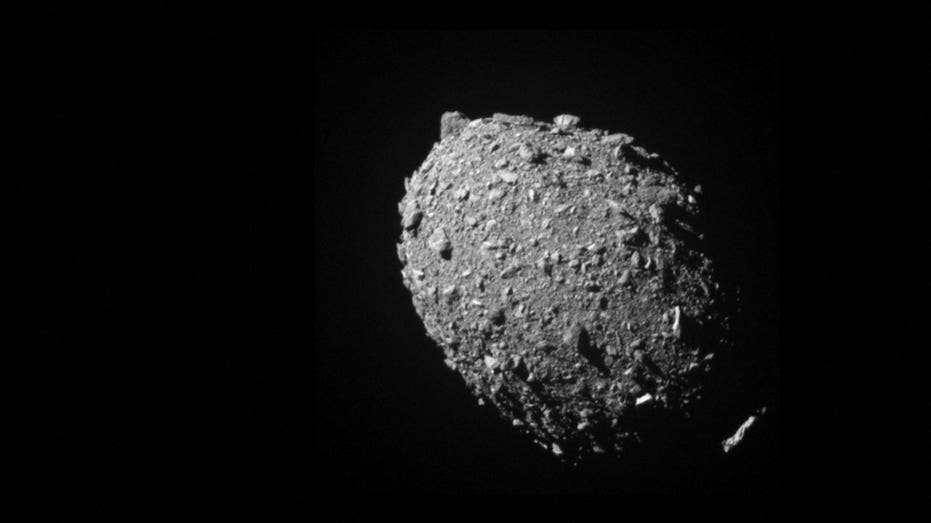Physical Address
304 North Cardinal St.
Dorchester Center, MA 02124
Physical Address
304 North Cardinal St.
Dorchester Center, MA 02124

Recent news has revealed the groundbreaking effects of NASA’s spacecraft collision with the asteroid Dimorphos. The successful collision, carried out by the DART spacecraft in 2022, has had a significant impact on both the orbit and shape of the celestial body. This mission has showcased the potential of asteroid deflection technology and highlighted the ability to alter the trajectory of asteroids to protect Earth from potential threats.
One of the most notable effects of the collision is the change in Dimorphos’ orbit around its parent asteroid, Didymos. Prior to the collision, Dimorphos followed a circular path, but as a direct result of the collision, its orbit has transformed into an elliptical shape. This alteration in the asteroid’s trajectory is a direct consequence of the momentum imparted by the DART spacecraft, pushing Dimorphos onto a new orbital path.
Scientists involved in the research have reported that Dimorphos now completes its orbit in 11 hours, 22 minutes, and 3 seconds, which is 33 minutes and 15 seconds shorter than its previous orbit. This change in the orbital period provides valuable insights into the dynamics and interactions between celestial bodies, emphasizing the effectiveness of the DART mission in altering the orbital characteristics of asteroids.
Another significant effect of the collision is the deformation of Dimorphos’ shape. Prior to the collision, Dimorphos resembled a slightly plump sphere. However, the collision has dramatically altered its appearance, leading scientists to describe it as a three-axis ellipsoid or a watermelon-like shape.
This change in shape could be attributed to the composition of Dimorphos, which consists of loosely aggregated fragments ranging from dust to gravel and rocks. The low overall strength of the asteroid allowed it to easily deform, resulting in the noticeable change in shape. This discovery provides valuable insights into the structural characteristics of asteroids and their response to external forces.
Following the collision, scientists have observed a gradual collapse of Dimorphos’ orbit over the course of several weeks. This collapse is believed to be a result of debris within the system being ejected and transferring angular momentum. As a result, Dimorphos’ orbit continues to contract, further emphasizing the dynamic nature of celestial bodies and the evolution of their orbits.
The impact of NASA’s collision with Dimorphos extends beyond immediate changes in orbit and shape. It serves as evidence of humanity’s ability to manipulate celestial bodies and mitigate potential threats to Earth. The success of the DART mission lays the foundation for future asteroid deflection technologies and underscores the importance of ongoing research and exploration in this field.
The collision between NASA’s spacecraft and the asteroid Dimorphos has resulted in significant effects on its orbit and trajectory. Prior to the collision, Dimorphos followed a circular orbit around its parent asteroid, Didymos. However, as a direct consequence of the collision, its orbit has transformed into an elliptical shape. This change in trajectory showcases the potential of asteroid deflection technology and the ability to alter the path of asteroids to protect Earth from potential threats.
Furthermore, the alteration in Dimorphos’ orbit has led to a significant reduction in its orbital period. It now completes its orbit in 11 hours, 22 minutes, and 3 seconds, which is 33 minutes and 15 seconds shorter than its previous orbit. This change provides valuable insights into the dynamics and interactions between celestial bodies, highlighting the effectiveness of the DART mission in altering the orbital characteristics of asteroids.
The collision has also had a profound impact on the shape and physical appearance of Dimorphos. Prior to the collision, the asteroid had a slightly plump spherical shape. However, the collision has caused a dramatic transformation, resulting in a three-axis ellipsoid or a watermelon-like shape.
This change in shape can be attributed to the composition of Dimorphos, which consists of loosely aggregated fragments ranging from dust to gravel and rocks. The low overall strength of the asteroid allowed it to easily deform, leading to the noticeable change in shape. This discovery provides valuable insights into the structural characteristics of asteroids and their response to external forces.
Following the collision, scientists have observed a gradual collapse of Dimorphos’ orbit over several weeks. This collapse is believed to be a result of debris within the system being ejected and transferring angular momentum. As a consequence, Dimorphos’ orbit continues to contract, further emphasizing the dynamic nature of celestial bodies and the evolution of their orbits.
The impact of NASA’s collision with Dimorphos extends beyond immediate changes in orbit and shape. It serves as evidence of humanity’s ability to manipulate celestial bodies and mitigate potential threats to Earth. The success of the DART mission lays the foundation for future asteroid deflection technologies and underscores the importance of ongoing research and exploration in this field.
If you’re wondering where the article came from!
#